Carnation Day, Dutch protest against the German occupier
Introduction
After seven weeks of German occupation, the reality of repression struck among the Dutch population. Many saw 29 June 1940, the birthday of prince Bernard, as being the moment to show the Germans that the Dutch people were not interested in national socialism at all. In the Netherlands, this day is known as `Anjerdag` or Carnation Day.
The beginning and the protests
The years before the Second World War Dutch citizens showed almost no interest in celebrating the birthday of prince Bernard. In previous years this day went by remarkably quiet. That’s why the Germans leaders didn’t expect any special problems. The secretary-generals who were in charge since the ministers had left, sent a circular that no festivities would take place in order to celebrate the birthday of prince Bernard because the Dutch population was still mourning about their war victims. In addition to the circular, Arthur Seyss-Inquart, Reichskommisar of The Netherlands gave head of Security Police Nockemann, the order to stay alert and keep a close watch, but not to interfere.
On the evening of the 28th of June, flowers had already been laid near the statue of Queen Emma on the Emma square in the city of Amsterdam. It had started with just one small flower but during the 29th of June more flowers were put near the statue. From flower arrangements the letter B was formed on the nearby lawn and cut out pictures from the Royal family were placed beside the flowers. A street organ began to play, and some of the attendees cautiously began to sing the National anthem, the Wilhelmus, and soon more people followed the example. Later that evening, members from the NSB wanted to remove the flowers, but the combative journalist Edouard de Nève, head of the air defense around the Emma square, gathered a group of volunteers and gave order to stop everybody who was trying to remove these flowers near the statue; hose them down he said. At some places flags were hung, people appeared on the street wearing a white carnation ("anjer" in Dutch) in the buttonhole on their coat, as an imitation of the white carnation that prince Bernard always wore in public. The Germans were not happy at all with this act of disobedience. They decided that all pictures and images of the Dutch Royal family had to be removed from all public places. Even later street names were renamed. The prince Bernard square was changed into Gooiplein. But not all protests against the German occupiers were peaceful and quiet. At different locations throughout the city of Amsterdam riots and disturbances took place. Over twenty-three people were badly injured because of fights between civilians and goons of the NSB.
In the city of The Hague, flowers were laid even earlier in front of the Noordeinde palace, nearby the statue of Willem de Zwijger on the 28th of June. First the police removed these flowers and took them inside the palace, but the mayor De Monchy of The Hague, gave order to bring these flowers outside again. On the morning of Saturday Marshal esquire Laman Trip laid down several congratulation registers in the hall of the palace, which was customary when a member of the Dutch Royal family was celebrating their birthday. When word got out that the opportunity existed to sign these registers people took this advantage and went out to the palace. One of the first to sign was mayor De Monchy. But when general Winkelman appeared the waiting crowd began to sing and the Dutch national anthem was sung several times. In the old palace of princes Juliana, Goebbels and commissioner general Schmidt were having a discussion, when they noticed several people walking by with orange decorations who were on their way to the palace Noordeinde. Immediately measures were taken. The commander ordered that the palace should be closed and the Noordeinde was deposited. The congratulation registers were immediately removed. He sought direct contact with Seyss-Inquart. Seyss-Inquart ordered that not the Dutch police but the German police had to shut down the Noordeinde Also if peace was not fully restored in the afternoon, the city of The Hague would be forced to pay a fine of one million guilders.
The citizens of The Hague didn’t take any notice. Later in the afternoon more people showed up, driving their bikes all dressed up in orange. The demonstration moved from the Noordeinde to the independence statue at square 1813 and near the monument of Queen Emma in the rosary on the Wassenaarse street. General Christiansen, the Wehrmacht commander, thought a real insurrection had broken out among the citizens of The Hague. He couldn’t understand why Seyss-Inquart didn’t interfere. Christiansen did the only thing within his power and ordered German fighter planes to fly above the city, preforming dives now and then, but not to shoot at the people. He was just trying to warn the citizens and also to scare them off.
In cities of The Hague and Amsterdam people went out on the street and protested against the German occupation. In different regions throughout The Netherlands people also protested, but there was a big differences between these several provinces. In Groningen, Friesland, Drente and Overijssel, people didn’t flag, while in Gelderland, people responded very enthusiastic to this day of national rebellion. In Utrecht, many flowers were laid in front of the closed fence from the Soestdijk palace, and a big crowd gathered and stayed there for a very long time. The most quiet provinces were Noord Brabant, Limburg and Zeeland, in the provinces of North and South-Holland more people got out on the streets.
German measures and consequences
The following day, Sunday the 30th of June, everything was back to normal. But when Seyss-Inquart returned from a meeting with Hanns Rauter, Nockermann informed him about what had happened the last few days. Seyss-Inquart didn’t tolerate this act of protest and took dramatic measures. Mayor Monchy was fired on the 1st of July and general Winkelman was captured as a prisoner of war and was taken away to Germany. Meanwhile Nockermann without informing Seyss-Inquart, had contacted Berlin about the events that had taken place the last couple of days. The content of the report was so disturbing that first it was send to Heydrich, who was on vacation on the island of Rügen. And later on to Adolf Hitler in person. Hitler was surprised and crossed that the city of The Hague did not severe bigger punishment. Seyss-Inquart, Christiansen, Schmidt en Rauter were immediately summoned to appear at the Fürher’s headquarters. Hitler didn’t demand tougher measures against The Hague but the unilateral action from Nockermann did cost him his position. He was recalled back to Germany and was later sent to the Eastern front where he would die in December 1941 of sustained injuries.
In the Netherlands measures were taken trying to remove the term Royal out of The Netherlands. Although officially there was never an announcement, the media was informed on the third of July that neither the functions or members from the Dutch Royal family nor ministers would be named on the radio any more. Names from the departments and institutions were modified. The Royal library was renamed National library. To avoid further problems in the near future such as the birthday from princes Irene and Queen Wilhelmina a proclamation was prepared which ordered that wearing an orange bow, laying flowers near monuments and singing the national anthem, was discouraged. Seyss-Inquart even went further on the 1st of August. Every action taken on a birthday of a member of the Dutch Royal family that could be considered a demonstration against German domination would be forbidden. Selling "Forget-me-not" flowers was forbidden because wearing or even selling these flowers would be seen as a act of protest against German occupation. The repressive measures soon had effect. On the 31st of August almost nobody celebrated the birthday of Queen Wilhelmina, at least not out in the open.
Conclusion
What the real reason was that the birthday of prince Bernard, a German against whom many Dutch citizens had objections, became a day of National resistance is not quite clear. It was common knowledge that the prince fought among the Dutch soldiers in the early days of May 1940 in The Hague and Zeeuws-Vlaanderen and how clear it was that he dissociated himself from his former country by fighting against his former compatriots. Also the fact that the Dutch Royal family stayed out of Adolf Hitler’s hands and escaped to Great Britain became an act of resistance which became a symbol of the will to resist for many people.
Seyss-Inquart wished that the Dutch Royal family soon would be forgotten. But the citizens of Holland thought otherwise. Their devotion to the Dutch family meant that they always found new targets. Soon after Anjerdag (Carnation Day in English) a poem spread all over the country which chaplain ds. W.Welter who solemnized the marriage of princes Wilhelmina and prince Bernard in 1937, dedicated to Queen Wilhelmina’s escape:
No it wasn’t a flee what ye did.
But following God’s voice
I’m not asking what’s happening inside you.
A battle, so tough, so deep.
We kneel near you and with you
Till God’s eyes and hand Return the Netherlands to orange
And Orange to the Netherlands.
What come will come
We worship, remain silent
The night is black, crepes the day
Lord Thy will be done.
Definitielijst
- Marshal
- Highest military rank, Army commander.
- national socialism
- A political ideology drawn up by Hitler based on the superiority of the German race, the leader principle and fierce nationalism that was fed by the hard Peace of Versailles. National socialism was anti-democratic and racist. The doctrine was elaborated in Mein Kampf and organised in the NSDAP. From 1933 to 1945 National socialism was the basis of totalitarian Germany.
- NSB
- National Socialist Movement. Dutch political party sympathising with the Nazis.
- resistance
- Resistance against the enemy. Often also with armed resources.
- socialism
- Political ideology aiming at slight or no class differences. Means of production are owned by the state. Evolved as a response to capitalism. Karl Marx tried to substantiate socialism scientific.
- Wehrmacht
- German armed military forces, divided in ground forces, air force and navy.
Images
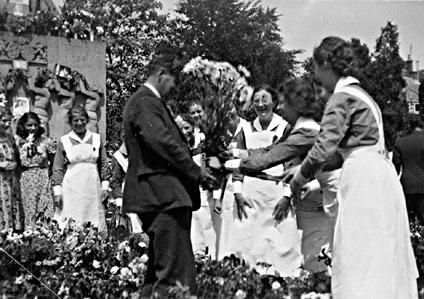 Flowers are laid by the statue of Queen Emma on the Emma square in Amsterdam. Source: Verzetsmuseum Amsterdam.
Flowers are laid by the statue of Queen Emma on the Emma square in Amsterdam. Source: Verzetsmuseum Amsterdam.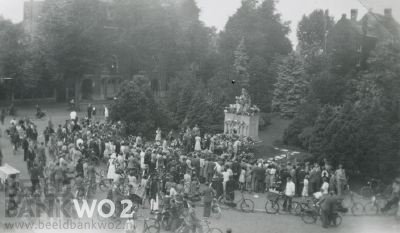 A crowd is gathered, also at the statue of Queen Emma in Amsterdam. Source: Beeldbank WO2.
A crowd is gathered, also at the statue of Queen Emma in Amsterdam. Source: Beeldbank WO2.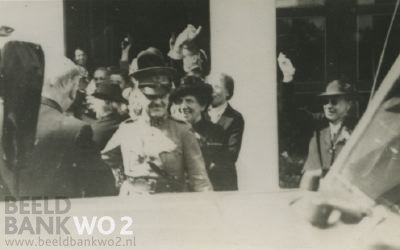 The Dutch general Winkelman is cheered by the people at the Noordeinde palace in the Hague. Source: Beeldbank WO2.
The Dutch general Winkelman is cheered by the people at the Noordeinde palace in the Hague. Source: Beeldbank WO2.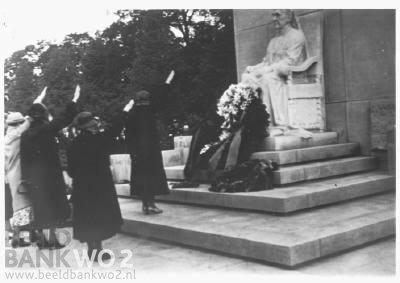 NSB-members at the Emma monument in the Hague on Carnation Day. Source: Beeldbank WO2.
NSB-members at the Emma monument in the Hague on Carnation Day. Source: Beeldbank WO2.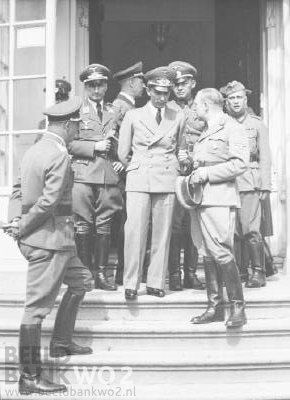 Goebbels in The Hague during Carnation Day. Source: Beeldbank WO2.
Goebbels in The Hague during Carnation Day. Source: Beeldbank WO2.Information
- Article by:
- Hans Molier
- Translated by:
- Han Smits
- Published on:
- 29-08-2013
- Last edit on:
- 15-06-2020
- Feedback?
- Send it!



